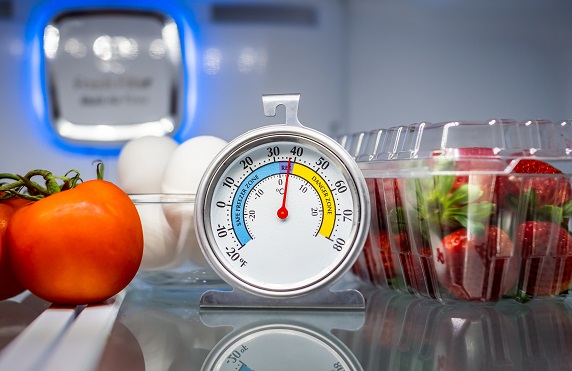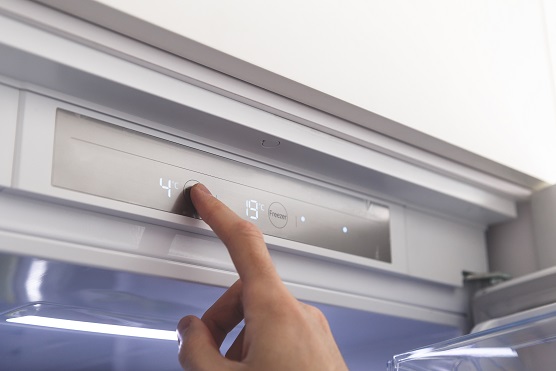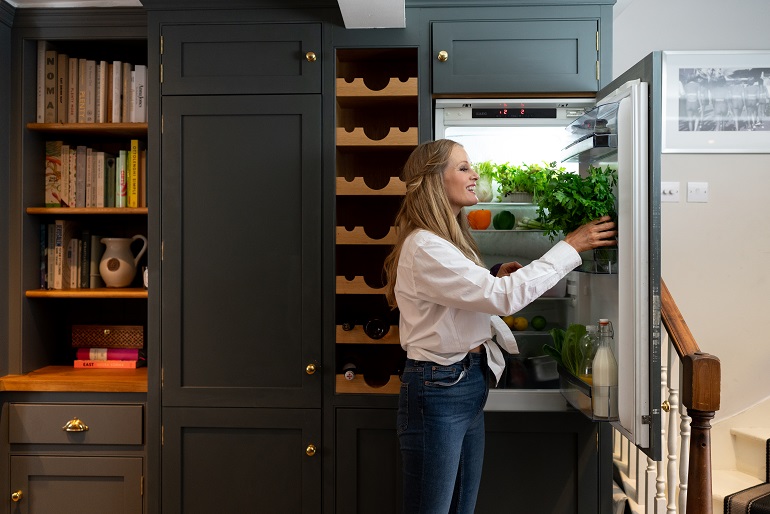Just like Goldilocks, your fridge likes things not too hot and not too cold. If it’s too warm, it risks letting food go off quickly. If it’s too cold, things will start freezing. So what temperature should a fridge be?
Here’s the short answer: 5 degrees Celsius (41 Fahrenheit) or under. Nasty bacteria thrive at between 8 degrees and 63 degrees, known as the ‘danger zone’. This is why the Food Standards Agency recommends keeping your fridge under 5 degrees to be safe.
This topic is a little more complex though, which is why we’re going to cover the details now.
Prefer to watch
The ideal temperature for your refrigerator

We said the ideal fridge temperature is 5 degrees Celsius (41 Fahrenheit) or below. However, the temperature will be different in the various areas of your fridge. This is useful, because not all foods should be stored at the same temperature.
It’s important not to assume that your fridge’s settings show the real temperature inside. The built-in thermometer might not measure the whole fridge, or it might be faulty and need a fridge repair. You should always check the temperature with a reliable thermometer.
Another reason your fridge might not show the real temperature is if it hasn’t had time to adjust yet. For a new fridge, it can take 24 hours for the inside to reach the desired coolness. Of course, this'll be quicker if you just want your fridge to be a bit colder than it already is. It’s best to wait a few hours after changing any settings before you measure the temperature again.
The temperature may vary in different areas or compartments
It’s a given that some parts of your fridge should be colder. How much colder, though?
Typically, the back and bottom of the fridge is the coldest part. This is because cold air sinks down, and the back of the fridge is farthest from the door.
It’s different for fridges with ice-making compartments at the top, which make the top colder. Meanwhile, frost-free fridges have less temperature difference between the top and bottom.
Here’s a guide to the temperatures you should aim for in different parts of your fridge:
- The salad (‘crisper’) drawers: 2 degrees Celsius
- The bottom shelf: 1 degree Celsius
- The upper shelves: 2 to 3 degrees Celsius
- The door: 3 to 4 degrees Celsius
This explains why we should keep things like uncooked meat on the bottom shelf, where it’s colder. Meanwhile, the fridge door is good for things like juice but not for milk, which goes off quickly.
How to measure the temperature of your fridge
Before you can get your fridge’s temperature right, you need to measure it accurately. Some fridges don’t have temperature markings at all, just a scale from 1 to 5. Even if your fridge does have a built-in thermometer, they're often a degree or two off the mark.
The reliable way to know the temperature in different areas of the fridge is with a thermometer. Fridge thermometers are available cheaply in both analogue and digital models.
Or if you have a traditional mercury thermometer already, the only other thing you need is a glass of water. Here’s what to do:
- Put your thermometer in the glass of water
- Leave them overnight in the part of the fridge you want to measure
- Look at the temperature when you open the door first thing in the morning
That’s it. To get the full picture, repeat this over a few days with the different parts of the fridge.
What to do if your fridge is too warm or too cold
Clearly, not many of us will measure our fridge’s temperature unless we suspect something’s wrong with it. Some of the tell-tale signs to look out for are:
- Food starting to freeze in the fridge
- Food isn’t cold when it comes out of the fridge
- Frost or ice building up inside the fridge
- Food regularly goes off before its ‘use by’ date
If you discover that your fridge is too warm or cold, you need to find out why. Depending on the cause, you may be able to solve the problem yourself.
Adjust the temperature settings

You may have set the temperature when you bought the fridge. Still, the settings could've been changed by accident or by someone else in the home. Either way, if your fridge seems too warm or cold, the first thing you can do is adjust the settings. Once you’ve done that, leave it for a few hours before checking the temperature with a thermometer.
Check for common faults
Unfortunately, it’s possible that your fridge has a fault that needs fixing. Maybe the door seal needs cleaning to shut completely, or perhaps you have a faulty power cable. If you suspect a fault like this, see our guide to the most common fridge faults.
Then there's the more serious fridge faults that often happen over time. Parts like the compressor, fan motor and condenser coils experience wear and tear, eventually breaking down. To solve these issues you’ll need to get professional help from a fridge repair expert.
Consider your fridge habits

Every time you open the fridge door, warmer air goes in. It’s worth checking that no-one is leaving the fridge door open and that it’s shutting properly every time.
Another point here is not to overfill your fridge. If it’s packed, the cold air won’t circulate as well through the fridge, leaving warm pockets. It’s recommended to leave about 20% free space.
Also avoid putting hot food straight in the fridge — give it some time to cool down first.
Have questions?
Our blog is loaded with more related articles

Fridge freezer tips
Common fridge freezer faults and how to fix them
If your fridge isn't working properly, there are some things you can do to check for faults. Read our guide on common fridg...
Read more

Fridge freezer tips
What is a smart fridge and do I need one?
What is the Internet of Things, how does it work and how will it impact on your life in the home.
Read more

Fridge freezer tips
Food that lasts longer outside the fridge
Not all foods are going to last longer by being kept at cold temperatures, here’s a rundown of what you should and should...
Read more
